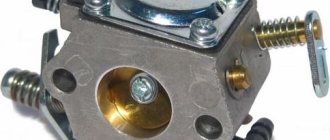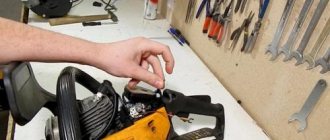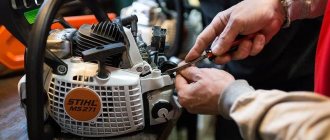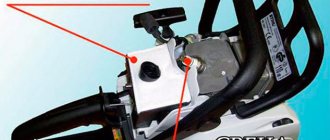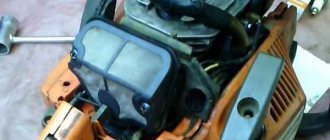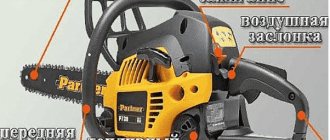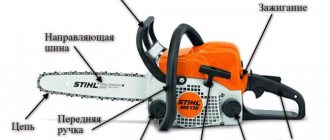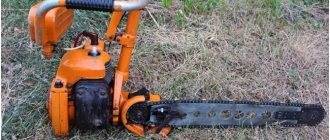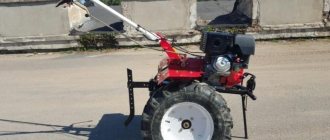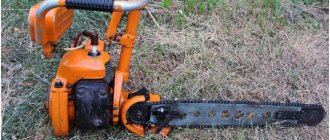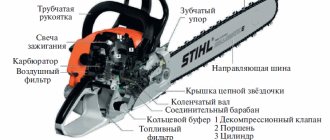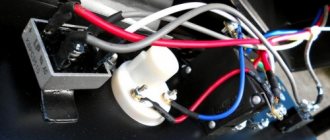Chainsaw carburetor design
Almost all carburetors used in the production of chainsaws have the same design. The only difference is the mechanisms with which Chinese garden tools are equipped.
As standard, the fuel unit consists of the following parts:
- float chamber - this element is designed to continuously maintain the required amount of fuel. When the unit is operating, fuel is transferred through a built-in nozzle to the atomizer;
- tube - through it, fuel enters in portions into the chamber. The fuel supply is regulated by the position of the built-in factory damper;
- atomizer - this part is necessary for injecting fuel into the intake air flow.
The operating principle of a chainsaw carburetor is quite simple. During operation of the unit, air is sucked into the tube and passes through it at a speed that is regulated by the built-in damper. When the damper opens, the float located in the chamber is activated. After passing through the diffuser, the air is mixed with fuel and instantly atomized. Next, the high-quality fuel mixture enriched with air passes through the intake channel and enters the engine cylinder. The diagram will clearly tell you about the operation of the carburetor.
The fuel circulates in the unit under pressure. In the float chamber it is close to atmospheric, but in the standard tube that sucks in the air, it is more rarefied. Due to the difference in the pressure generated, the fuel mixture enters the tube. The greater the amount of fuel, the higher the speed the engine of a household chainsaw can create.
How to flush a chainsaw carburetor?
You can clean the carburetor on a chainsaw using any aerosol cleaner. The brands Mannol, Hi-Gear and Nowax have proven themselves best. These compounds are good at cleaning the walls and parts of the carburetor from accumulated dust, carbon deposits and hardened resin.
Both Chinese and German carburetors are washed in the same sequence.
Cleaning the carburetor on a chainsaw is performed in the following order:
- First, you need to drain the used fuel remaining in the fuel tank. Next, you need to unscrew the mount and remove the protective cover of the chainsaw body, and also remove the standard air filter;
- Next, you need to remove the hose responsible for supplying fuel. To do this you will need to open the latches. After this, you need to unscrew the fasteners and remove the top cover of the factory assembly housing;
- Next you will need to remove the cover with the blue gasket, which plays the role of a fuel pump membrane. Near the body there are brackets in the form of springs. They will need to be removed and the screws removed;
- Then you need to unscrew the screw and carefully remove the needle valve. Directly below it is a built-in spring, which also needs to be removed. After this, you need to pull out the damper and the standard axle, carefully pulling them along towards you;
- After this, you will need to remove the drive arm, as well as the throttle body and its factory axle;
- All extracted parts of the chainsaw carburetor will need to be laid out on paper and their integrity checked. If necessary, worn parts must be replaced;
- Next, all dismantled parts must be washed with a spray can. The same must be done with the float chamber and carburetor body.
- After complete drying, all parts must be installed in the reverse order.
After washing, the carburetor will need to be installed in its regular place in the chainsaw. Next, you will need to start the garden tool and observe its operation at idle and maximum speed.
Adjusting the chainsaw carburetor
This procedure is necessary specifically in cases where a garden tool does not start or, after starting, immediately stalls. Adjusting the carburetor of a chainsaw is also necessary when its power has dropped or the amount of fuel consumed has noticeably increased.
For self-adjustment, each manufacturer includes adjusting screws in the package of their garden equipment. The bolt, marked H, is used to adjust the position of the main jet and the operation of the internal combustion engine at high speeds. Bolt L is necessary for basic adjustment of the position of the built-in idle speed jet generated by the motor. Accordingly, the T screw is required by the chainsaw owner to quickly adjust the idle speed of the factory engine. In some cases, this bolt is also marked with the letters S or LA.
Adjusting a chainsaw carburetor - what does a beginner need to know?
Initially, all adjusting bolts are in the factory positions - this guarantees the absorption of the optimal amount of fuel and air. However, due to prolonged use of the saw in difficult conditions, the factory settings of its carburetor may be disrupted. Even a slight shift of one of the bolts by 1/5 of a turn will lead to serious disruption to the operation of the saw motor. Therefore, the operator must constantly ensure that the adjustment bolts are in the optimal factory-set positions.
If for some reason the operation of the node was disrupted, it will need to be configured again. For this purpose, the unit has 3 adjusting bolts. The first of them is designated by the letter H - it is needed to tune the chainsaw engine when operating at maximum speed. The second screw, marked L, is used to adjust the motor while it is running at low speeds. The third screw may be marked T, S or LA. Its task is to adjust the internal combustion engine when operating in idle speed mode.
Setting up a chainsaw carburetor must be carried out with a fully functional engine. Immediately before adjustment, you will need to inspect the air filter and, if necessary, clean it or replace it.
How to properly adjust the carburetor on a chainsaw?
Before setting up the carburetor on a chainsaw, you need to carefully prepare for the procedure. First of all, you need to find descriptions of the angles of rotation of the adjusting screws in the instruction manual. If you arbitrarily turn the bolts without following the manufacturer's instructions, this can lead to serious damage to the engine of the tool.
The motor itself must be in full working order. You should also thoroughly clean the air filter before tuning. Otherwise, it will not be able to pass air in the volume required to enrich the fuel mixture, which will lead to incorrect carburetor settings.
Adjustment of the unit must be performed on a flat surface. The saw itself should be installed so that its saw attachment is located away from the operator's feet and face. Immediately before tuning, you will need to remove the upper part of the protective plastic body of the tool, as well as remove the foam rubber and part of the standard air filter. To configure the unit, you will need a thin shaped screwdriver.
The chainsaw becomes stubborn (+);
Hello. Out of ignorance, I broke one commandment - not to pick up devices with internal combustion engines at a landfill, and took a chainsaw there.
The thing that won me over was that the starter was resisting - there was compression.
There is also a spark, good and energetic.
The device breathes gasoline vapors; gasoline did not leak out of the spark plug hole.
I diluted the unknown gasoline that was in the saw with undiluted known working gasoline (about half to half).
I changed the spark plug (tried three different ones, one of them was new)
I read on the Internet how to adjust the carburetor and set the obviously “working” settings.
I took an old Soviet compression gauge, bent over, stuck it to the spark plug hole, pulled... with two or three pulls I inflated 7 atm without any problems (I consider this a quite “real” value, even if it’s not a fresh engine). However, I’m not sure that I tucked the device in tightly enough. Inconvenient - terrible! I climbed with a flashlight to look at the piston from three sides - I liked it. Very slight traces of the joint work of the piston and cylinder, not a hint of pathological wear.
The motor rests on nothing!
I read here on the forum that the magnet on the flywheel may have “something strange there”, which is why the ignition timing is gone. Unlikely, but still?!
I also read that air leaks in the engine (under the piston) can be decisive. Replacing crankshaft bearings and seals - will it help?
Pouring fuel directly into the carb and/or cylinder did not result in contractions.
With numerous jerks (and regular cleaning of the spark plug), I observed variable resistance on the starter, which may seem like flashes of the mixture in the engine (but at the wrong time, since it won’t start).
Once with an old candle and having just heated the candle well on a hair dryer, with a hot candle the saw started up! for about 5 seconds, I didn’t even have time to put on the gas, it stalled again and that’s it, that’s all she called.
Another day I brought her a new candle, before screwing it in - let me pull it! I just read on the Internet how to start a saw correctly. Jerg! From the very first kick it starts for 2-3 seconds and again there is dead silence.
Additional question. There is an old Soviet strobe, which, when connected to 12 V, squeaks quite disgustingly. It was not possible to get the strobe to work. Maybe I'm doing something wrong? Should the signal wire only touch the BB wire going to the spark plug?
Please advise what else can be done! I created the topic out of a lot of emotions, it’s necessary to rely so much on the piece of hardware in which there seems to be nothing to break! :pardon: What do you think?
I almost forgot: the Komatsu Zenoah G380 machine, the Internet knows practically nothing about it.
I licked the carburetor settings from here. Modified on December 29, 2010 by young technician
What to do if gasoline does not flow into the carburetor of the chainsaw?
The first reason for this failure is that the fuel filter is clogged with dust and dirt. This happens due to the presence of a large amount of harmful impurities in gasoline and the used motor oil. Over time, they accumulate on the surface of the filter, causing it to lose its ability to pass fuel. To solve the problem, you will need to thoroughly clean the filter by rinsing it in a bath of cleaning agent. If the filter develops holes or other signs of wear, it needs to be replaced immediately.
The second cause of failure is contamination or breakage of the tube through which fuel is supplied to the carburetor. If the hose is not torn, then cleaning it will be enough to thoroughly blow it with compressed air from an aerosol. If the tube is broken, it will need to be replaced. When installing the hose, the joints between it and the fittings must be carefully treated with sealant.
There is one more malfunction that occurs much less frequently than the previous two. It consists of a breakdown of the valve that regulates the rate of fuel supply to the carburetor. If dust or small chips get inside its mechanism, the damper is blocked and remains in the closed position. Repair of the unit can only be done by replacing the damper, since it most often cannot be restored.
Gasoline does not enter the chainsaw carburetor
If fuel does not enter the standard chamber, this may indicate several breakdowns at once. First of all, you need to check the air and fuel filters. During long-term operation of the saw, these elements absorb large amounts of dust, which subsequently prevents the infiltration of clean air and fuel. A slightly dirty filter can be cleaned with gasoline, but if the part is clogged with a large amount of dust, it will need to be replaced.
Another reason
the fault lies in the needle. This part tends to stick, especially in Chinese-made chainsaws. In most cases, simply moving the needle will be enough to fix the problem.
If fuel does not enter the chamber, the saw owner should inspect the tool seals. After several months of using the tool, these parts lose their tightness. Over time, they begin to leak gasoline, as a result of which the tool stops starting. Repair is carried out by replacing the seals.
When starting the saw, the breather plays an important role. It is located near the gas tank cap of the saw, and performs 2 tasks at once - it maintains optimal air pressure and prevents fuel from leaking out. To check the breather, you will need to disconnect the fuel supply pipe and see how much gasoline flows out. If it does not flow out at all, it means that the standard breather is clogged with debris and dirt. In this case, you will need to clean the element and reinstall it.
If fuel does not enter the chamber, then you need to check the fuel line. Most often, to complete a budget class tool, a Chinese hose is used, which loses its tightness over time. In this case, it will be necessary to replace the line, paying special attention to the tightness of the channel joints.
Why does a chainsaw shoot into the carburetor?
Often, chainsaw carburetor malfunctions are associated with loud extraneous sounds that come from the unit. Ignoring them will lead to even more serious damage, which will be much more difficult to eliminate.
First of all, you need to understand the causes of extraneous sounds. The first of them is an incorrectly set ignition, due to which the used fuel does not have time to burn in the internal combustion engine cylinder in time. This leads to the formation of a short-term shooting noise that is repeated with each cycle of fuel injection into the cylinder.
To fix the problem, you need to adjust the gap between the flywheel and the standard ignition coil of the chainsaw. To do this, you need to remove the left protective cover of the plastic case and clean the parts underneath. To the right of the ignition coil there are 2 screws, turning them counterclockwise will allow you to move the flywheel away from the standard coil. Next, you will need to attach a template to the side of the coil and begin to slowly turn the factory screws in the opposite direction. As soon as the built-in flywheel comes close to the previously installed template, you will need to stop turning the screws.
After adjusting the ignition gap, you need to check the operation of the chainsaw. If it still fires, then you need to inspect the spark plug. If carbon deposits have accumulated on it, the part must be cleaned and completely dried.
Another reason why the chainsaw you are using is firing is due to the incorrect proportion of the prepared fuel mixture. If there is too little gasoline or motor oil, the engine of the garden tool will not be able to operate stably. In this case, you will need to completely drain the fuel and prepare the mixture in accordance with the manufacturer's instructions.
In some cases, a disturbance in the supply of fuel to the engine cylinder may be caused by improper operation of the standard carburetor jets. In this case, you will need to adjust the carburetor and alternately check the operation of the tool at idle, low and high speeds.
Gasoline does not enter the chainsaw carburetor
If fuel does not enter the standard chamber, this may indicate several breakdowns at once. First of all, you need to check the air and fuel filters. During long-term operation of the saw, these elements absorb large amounts of dust, which subsequently prevents the infiltration of clean air and fuel. A slightly dirty filter can be cleaned with gasoline, but if the part is clogged with a large amount of dust, it will need to be replaced.
Another cause of malfunction is the needle. This part tends to stick, especially in Chinese-made chainsaws. In most cases, simply moving the needle will be enough to fix the problem.
If fuel does not enter the chamber, the saw owner should inspect the tool seals. After several months of using the tool, these parts lose their tightness. Over time, they begin to leak gasoline, as a result of which the tool stops starting. Repair is carried out by replacing the seals.
When starting the saw, the breather plays an important role. It is located near the gas tank cap of the saw, and performs 2 tasks at once - it maintains optimal air pressure and prevents fuel from leaking out. To check the breather, you will need to disconnect the fuel supply pipe and see how much gasoline flows out. If it does not flow out at all, it means that the standard breather is clogged with debris and dirt. In this case, you will need to clean the element and reinstall it.
If fuel does not enter the chamber, then you need to check the fuel line. Most often, to complete a budget class tool, a Chinese hose is used, which loses its tightness over time. In this case, it will be necessary to replace the line, paying special attention to the tightness of the channel joints.
How to extend the life of a carburetor?
To prevent the breakdown of a standard unit, the owner of a garden tool should adhere to a number of rules. These include:
- using a properly prepared fuel mixture - each time you mix gasoline and engine oil, you must strictly adhere to the proportions specified in the operating instructions;
- use for refueling gasoline of the brand specified by the manufacturer - for operating an engine running on AI-92 gasoline, AI-95 fuel is not suitable, and vice versa;
- regular washing - cleaning the unit from dust and dirt accumulated on the walls will make its daily work easier;
- tuning the unit immediately after detecting problems - there is no need to delay adjusting the carburetor, as this can lead to even more serious damage.
During operation of the chainsaw, you need to ensure that dust, sawdust and small debris do not seep under its body. Otherwise, they will quickly clog the carburetor and block its operation.
Carburetor adjustment
In many ways, the service life of the structure depends on the quality of the assembly. Quite often there are problems with Chinese chainsaws associated with wear of the main elements. The low cost of the proposal is due to the use of low-quality materials.
There are several main signs that indicate that the carburetor needs to be adjusted:
- Strong vibrations occur during work.
- The CPG is worn out.
- There are signs of mechanical damage to the protective cap.
- The engine shuts down on its own or is almost impossible to start.
- Fuel consumption and the amount of exhaust gases increase for no reason.
- A sharp drop in power indicator.
Recommendations for adjusting the element in question are provided by the device manufacturer. As a rule, adjusting screws are placed in the protective cap, which allow you to adjust the operation of the chainsaw.
Often problems with operation arise due to changes in the settings of the fuel supply system. Safety precautions when troubleshooting carburetor problems include the absence of fuel. The entire procedure can be divided into two main stages:
To begin with, the position of the screws H and L is changed until they stop, after which they are turned back 1.5 turns. The final stage involves warming up the internal combustion engine for 10 minutes, since some characteristics change when heated. The adjustment is carried out using a special screw, which is set to a position to reduce the speed. The chain must be stationary.
No. 1. Chainsaw won't start
If difficulties arise with starting a chainsaw, many immediately blame the carburetor. In fact, there are several options and the cause of the malfunction can be any:
- Air and/or fuel filters are clogged. The problem can be solved by cleaning the filters.
- Lack of fuel in the tank. Yes, there is such a reason - some owners forget about such an insignificant detail as refueling a chainsaw and think that a couple of liters of gasoline will last for six months. In addition, fuel in the tank should not be stored for more than 14 days, because gasoline evaporates and the octane number is lost.
- Check the pipe from the fuel tank to the carburetor - it could be clogged or broken, so gasoline does not flow into the tank.
- There is no spark at the spark plug. Why there is no spark - there can be many reasons: there is no contact, the spark plug needs to be changed or it is flooded. Why the spark plug on a chainsaw fills is another question. But if this happens, you need to dry it and reinstall it, and then check for a spark. If there is heavy carbon deposits on the spark plug, it is recommended to replace it.
- Check the muffler for carbon deposits. If there is carbon deposits, thoroughly clean the muffler, but it is still recommended to take the chainsaw to a service center to have the cylinder and piston checked, because carbon deposits are a sure sign of improper operation of the elements of the cylinder-piston group.
- The carburetor is clogged. How to properly adjust a chainsaw so that the carburetor works well is discussed in a separate article.
If none of the above methods helped, then the reason is more serious - a breakdown of one of the connecting rod-piston group units. In this case, it is recommended to take the chainsaw to a service center.
Chainsaw Sneezes and Stalls
Content
The chainsaw starts and stalls, the reason
A chainsaw has long been no longer a luxury, but a necessary tool for anyone who has at least some suburban area. With its help you can carry out gardening work, harvesting firewood, processing lumber and much more. There are many models of chainsaws on sale, varying both in power and overall quality. You can verify this here. e-catalog.ru.
But no matter what equipment can be capricious, and chainsaws are no exception. Let's look at more relevant difficulties.
The tool stalls immediately after starting
One possible reason is a lack of fuel. Check the amount of fuel in the gas tank and add as needed. In all this, you should strictly follow the advice in the instructions, especially with regard to the properties of gasoline and oil. In our country, such subtleties are often ignored, filling the saw with whatever is necessary, which causes accelerated wear of the motor and leads to failures.
READ Chainsaw Calm Doesn't Start Reasons
The saw may also stall due to deterioration in the contact of the spark plug with the high-voltage wire. This may be caused by mechanical shear or carbon deposits. From time to time, it is recommended to occasionally replace the candle with a new one, even if the old one did not show any problems in operation.
Chainsaw stalls when pressing on gas
The video discusses a fairly common malfunction of chainsaws
and 100% carburetor option method. How did you do it?
The chainsaw stalls when you press the gas
The chainsaw stalls
when you press the gas.
The Partner 370
chainsaw to stall with the slightest pressure on the handle.
The chainsaw can work normally when in a straight horizontal position, but stalls when tilted to the side. Usually this is also associated with a lack of fuel: the fuel tube rises when tilted, and if there is not enough fuel, it rises above the fuel level.
Chainsaw stops idling
Firstly, it is recommended to check the muffler, because its contamination can lead to a deterioration in the exhaust gases, which is why the engine stops.
READ What is the gap on a Calm chainsaw
If cleaning the muffler did not help resolve the problem, and your saw has a carburetor engine, then you can try adjusting it. Most engine models have coarse and fine adjustment bolts (H and L, respectively). By increasing the engine speed with their help, you can eliminate the problem. Keep in mind that carburetor adjustment is a fairly specialized process that requires the implementation of a tachometer.
The engine cannot withstand the load
If the chainsaw stops right in the middle of a particularly thick log, then the problem may be caused by problems in the fuel supply system or problems with the air filter. The engine simply does not get enough flammable consistency to work with a heavy load, and it stops.
The usual solutions to these problems are changing the fuel in strict accordance with the advice in the annotation (we have already talked about this) and cleaning (replacing) the air filter.
The chainsaw stalls when the speed increases
The reasons for this phenomenon are similar to the previous ones: either the problem is in the fuel system or in the air filter. Try disconnecting the fuel hose from the carburetor - if gasoline flows poorly (but you know for sure that there is fuel in the tank), then the reason is the gasoline filter. You can also check the fuel pump - fuel should not leak through it. If this happens, then it is advisable to replace the pump.
READ How to Adjust the Carburetor on a Chainsaw Caliber
No. 2. The engine stalls
The engine starts, but the chainsaw stalls at idle or under load. In this case, most often you should perform the same actions as described above.
How to adjust a chainsaw depends on exactly when the problems start:
Stalls immediately after starting:
- The fuel mixture is not prepared correctly, there is too much oil in it, so the octane number of gasoline is less than it should be, so the chainsaw only runs on choke or stalls immediately.
- Carbon deposits on the spark plug or improper gap between the spark plug and the wire.
It stalls and does not work at idle:
- The muffler is clogged. It is necessary to remove carbon deposits.
- The carburetor settings are off. The idle speed on the chainsaw needs to be adjusted. This is done using adjusting bolts marked L and H. For how to adjust idle speed, see the article about adjusting the carburetor.
Stalls at maximum speed and only runs on choke
- The air or fuel filter is clogged. The seals need to be cleaned and checked.
- The breather is clogged and because of this, fuel does not flow and pumping gasoline on the chainsaw does not work. Take the needle and carefully clean the breather.
- Fuel pump malfunction. Remove the pump and check to see if gasoline is leaking from it. If it oozes, replace the sealing gasket or the pump itself.
The chainsaw does not cut under load and stalls
- The air filter is clogged. It is necessary to take out the filter, clean it well or even rinse it, dry it and install it back.
- Wrong proportion of oil/gasoline mixture. Drain the fuel and remix the oil and gasoline in the correct proportions.
The chain doesn't cut
A decrease in chainsaw performance is associated with blunting of the chain teeth. This is the most common problem because... sharpening must be done regularly. How to do this using a machine, file or grinder, read the corresponding article.
Stalls at maximum speed and only runs on choke
- The air or fuel filter is clogged. The seals need to be cleaned and checked.
- The breather is clogged and because of this, fuel does not flow and pumping gasoline on the chainsaw does not work. Take the needle and carefully clean the breather.
- Fuel pump malfunction. Remove the pump and check to see if gasoline is leaking from it. If it oozes, replace the sealing gasket or the pump itself.
No. 3. The engine "shoots"
If during operation there are extraneous sounds similar to gunshots, then there is a problem with the muffler or carburetor. How to make a chainsaw run quietly? It depends on which node is faulty.
Shoots the carburetor:
- Ignition is too late - the air-fuel mixture does not have time to burn out in the cylinder, so the sound is similar to a small explosion.
- Lean air-fuel mixture. Too little gasoline enters the mixture - the chainsaw, or rather the jets, needs to be adjusted to increase the fuel supply. Why the chainsaw revs on its own is for the same reason.
Shoots at the silencer:
- Enriched air-fuel mixture. Why does a chainsaw “shoot”? There is too much gasoline and not enough air in the mixture, so the mixture does not completely burn out in the chamber and partially burns out in the muffler. Carbon deposits on the exhaust are a clear sign of this. The air filter needs to be cleaned or the carburetor adjusted.
Chainsaw Shoots Silencer
A motorcycle shoots at the muffler - a solution to problems.
Owners of not only Russian-made bikes, but also foreign cars, often encounter the problem of “shooting” from the muffler. This happens due to improper care of the air-fuel mixture ignition system. The bike shoots the muffler in several cases:
- when using bad gasoline;
- malfunction of the electronics system responsible for the fuel supply;
- gasoline does not enter the combustion chamber in pure form;
In such cases, you don’t have to wonder why the muffler on the bike shoots. Why it shoots into a silencer - common. Gasoline of disgusting properties has a very high combustion temperature due to the addition of water, so it does not ignite one hundred percent. The remaining drops fall on the walls of the heated muffler . Their ignition creates pops.
Also the motorcycle shoots
into
the muffler when releasing gas.
The lower the pressure created in the internal combustion chamber, the more droplets enter the muffler. On some bikes, fuel accumulates in the muffler, followed by rare but very loud bangs. Most often, but not always, owners of the Russian motorcycle industry face this problem. Why does the muffler shoot and what are the reasons? For example, a Ural motorcycle shoots
into the carburetor. This occurs due to direct clogging of gasoline in the carburetor itself. To avoid this problem, it is necessary to constantly clean the filters and change the consumables responsible for cleaning the engine. Proper operation of your bike will not only ensure good engine performance, but will also maintain factory specifications.
Answers to questions, pops in the muffler and longitudinal runout of the crankshaft
I tried to explain why there are pops in the muffler
at idle speed and whether it is necessary to remove the longitudinal.
It shoots either at the carburetor or at the muffler
I sharpened the rubber appendage onto al. circle a little bit, assembled it and everything worked. I didn’t remove the second part.
What do the shots affect?
Problems with the ignition system do not bode well. In such a situation, with prolonged engine operation, not only the aesthetic impression can deteriorate. A dirty carburetor or low-quality fuel will eventually disrupt cylinder compression, which in turn will lead to engine failure.
To understand why a Ural motorcycle shoots at the muffler, or any other bike, you should check the problem areas. Here are possible ones:
- not tightness of the pipes that can suck in air, or the exhaust tract;
- faulty spark plugs;
- dirty air filters or carburetor;
- difficulty in supplying fuel;
However, the problem may also be with the racers' rev limiter. The spark plugs do not charge continuously, causing most of the mixture to go straight into the exhaust system, where it hits the hot metal and ignites, creating a loud bang. A clear example of such a process is a motorcycle equipped for special show programs. Why does a chainsaw shoot into the muffler? It shoots at the Gasoline Saw, not the engine slamming into the muffler while working. On such bikes, some of the fuel mixture ignites directly in the exhaust pipe, which is why you can see a flame coming out of the muffler.
Under no circumstances should you install forward flow if you experience popping noises. This will only increase the noise in the exhaust system. This happens due to an even greater depletion of the fuel-air mixture and a “gutted” muffler.
In conclusion, we highly recommend watching a competent video about problems in the engine, where, among other things, the issue of shots into the muffler is covered in sufficient detail.
No. 4. Chainsaw overheating
Why does the chainsaw get hot? The engine or tire may overheat - in any case, the fault is due to a small amount of lubricant.
- Engine overheating. The proportion of the fuel mixture is incorrect or pure gasoline is poured. Drain the fuel and make a mixture using the correct proportions of oil and gasoline, as specified by the manufacturer.
- Tire overheating. The oil pump needs to be cleaned or adjusted because... No oil is supplied to the tire.
No. 6. The chainsaw cuts to the side
When cutting, you may notice that the result is an uneven cut. Why does a chainsaw cut crookedly? There are several reasons:
- Incorrect chain sharpening. The teeth are sharpened at the wrong angle or only in one direction. Proper sharpening is required.
- Incorrectly selected chain. At very high speeds, a difference of even 0.2-0.3 mm between the width of the groove or the width of the seat will be visible, which is why the chainsaw cuts to the side. An appropriate circuit must be installed.
- Uneven tire wear. Over time, the tire wears out on one side and then the chain pulls to the side. Rotate the tire regularly to ensure even wear on both sides. If the wear is excessive, replace the tire.
No. 7. Chain lubrication problems
For normal operation, the chain must be constantly lubricated to reduce friction between the bar and the links, and also to prevent premature wear of the links.
- If the chain on the chainsaw is not lubricated, then there is a problem with the oil pump - oil is not supplied due to a clogged channel. Lack of lubrication is the reason why the chain stretches or why the chain breaks. Clean the channels; tiny particles of chips constantly get there and clog them. The oil hose may also break. If you need to adjust the chainsaw oil pump or repair it, it is better to contact a service center.
- Oil splashes from the chain. Incorrectly selected lubricant - it is too liquid, so it does not so much lubricate the links as it splashes onto the wood. Replace the lubricant with a thicker one.
Malfunctions of the chain lubrication system
In order for the device to work for a long time, as well as to simplify the sawing process, chainsaws have a special lubrication system. It runs on an oil pump, which can fail from time to time. The lubrication system can be checked as follows:
- Special oil is poured.
- The chainsaw is placed near a vertical surface.
- The saw turns on and the speed increases slightly.
Proper chain lubrication allows for a slight spread of lubricant.
No. 8. The chain falls off
Why does the chain fall off the tire? There may be several reasons and they are all different:
- Worn drive or driven sprocket. Due to the fact that the sprocket is worn out, the grip on the chain decreases, which is why the chain flies off the chainsaw. The sprocket needs to be replaced.
- The chain has stretched. Why the chain on a chainsaw stretches is due to insufficient lubrication. The metal heats up and stretches, even by a fraction of a millimeter, but if you take into account the number of links, then even 3-4 mm is enough for the chain to fly off the bar. The chain needs to be replaced.
- The chain tensioner that regulates its tension has become loose. how to regulate a chainsaw, or rather the chain tension? You need to adjust the tensioner - this can be done in just a few minutes.
No. 9. The chain does not rotate
Why doesn't the chainsaw chain rotate when the engine is running even at full speed?
- Leading sprocket. Either it is jammed, or the crown is worn out so much that it does not engage and the chain does not spin on the chainsaw. In any case, it is necessary to disassemble the sprocket to find out the exact reason why the chain does not spin. If the crown is worn out, it is necessary to replace the sprocket (or the crown itself, if the sprocket has a prefabricated structure).
- The chain brake is stuck. As a result, the sprocket is blocked by the brake mechanism, while the motor runs. It is necessary to turn off the engine and release the brake. If this happens under load, the brake mechanism will have to be changed, as well as the sprocket, because Due to the high temperature, many elements can melt and overheat.
No. 10. Chain brake does not work
All chainsaws are equipped with a main and inertial (emergency) brake. The latter turns on only when a backfire occurs. The main brake is designed to stop the chain while the engine is running. Why does the chain on the chainsaw jam and it doesn’t stop? Option two:
- The brake band is badly worn and does not provide sufficient stopping effect. The brake band needs to be replaced.
- Contamination of the tape. When working, debris may become clogged in the under-cover space: shavings, sawdust, dirt, etc. Debris is blocking the brake mechanism, so if the brake does not work, you need to clean the brake mechanism.
Home page » Chainsaw Shoots Carburetor
Chainsaw maintenance and repair
By taking into account the manufacturer's recommendations, you can significantly extend the service life of the device. Other specific faults include:
- Starter failure.
- Incorrect operation of the brake system, which stops the chain.
- Worn bar or saw chain.
Fault repair methods are selected depending on the design itself. In some cases, it is necessary to replace the entire assembly, in others only individual elements.
If you find an error, please select a piece of text and press Ctrl+Enter.
Home page » Chainsaw Shoots Carburetor
Related Posts
The chainsaw does not start: causes and solutions
Today, it is probably difficult to find an owner who does not have such a universal, practical, and multifunctional tool as a chainsaw.
This device is deeply rooted in everyday life, and this is not surprising because the chainsaw has become an indispensable assistant for us in the field of cutting wood of various types, preparing firewood for the winter, cutting down trees, and it is also used in the construction industry, etc.
Naturally, one can talk endlessly about its positive aspects and it copes with its task simply superbly . But, like any technology, no matter how unique and highly practical it is, it breaks down over time and that’s normal. Why does the Ural chainsaw shoot into the carburetor? Cause of malfunction, consequences. Why does a chainsaw shoot into the muffler? The most important thing at this moment is to correctly determine the cause of the malfunction and quickly eliminate it.
Naturally, you can turn to various kinds of services that, for a fee, will put your equipment in order. But you will have to pay a significant cost. What for? After all, you can try to determine the extent and cause of the breakdown yourself and fix it.
Since there are such minor breakdowns that can be repaired within five minutes. We will talk about them and ways to eliminate them in this article.
Plant structure
The first and practically main element of a chainsaw is the engine, namely a two-stroke carburetor (see carburetor adjustment). Its direct power can be varied, it all depends on the model of the device and its intended purpose. Chainsaw set The second no less important part of the tool is the set (saw) which consists of a chain (cutting), bar, sprocket, wheel (chain) . It is worth adding to this that completely different manufacturers provide their own specific range of this headset.
It is important that it always needs to be directly selected from the specific characteristics of the engine. Since the larger the pitch of this type of headset, the deeper the chainsaw’s cut will be, one might even say that the more powerful and productive it will be. Often chainsaw owners think about why the chainsaw shoots into the carburetor, or why gasoline does not flow into the chainsaw carburetor? But do not forget that for the device to fully operate, the engine should also not be inferior to it in terms of power.
Its lubrication is carried out using special oil directly from the second tank, which is located on the hand unit. It is worth noting that the mass of this type of tank has such features that the oil and fuel intended for the engine run out at the same time.
We have figured out the general outline of the device, and most likely its basis, and now it’s time to start understanding why the chainsaw stopped working, what the reasons could be for this and how to eliminate them.
Chainsaw Shoots Carburetor
The chainsaw does not start: causes and solutions
Today, it is probably difficult to find an owner who does not have such a universal, practical, and multifunctional tool as a chainsaw.
This device is deeply rooted in everyday life, and this is not surprising because the chainsaw has become an indispensable assistant for us in the field of cutting wood of various types, preparing firewood for the winter, cutting down trees, and it is also used in the construction industry, etc.
Naturally, one can talk endlessly about its positive aspects and it copes with its task simply superbly . But, like any technology, no matter how unique and highly practical it is, it breaks down over time and that’s normal. Why does the Ural chainsaw shoot into the carburetor? Cause of malfunction, consequences. Why does a chainsaw shoot into the muffler? The most important thing at this moment is to correctly determine the cause of the malfunction and quickly eliminate it.
Naturally, you can turn to various kinds of services that, for a fee, will put your equipment in order. But you will have to pay a significant cost. What for? After all, you can try to determine the extent and cause of the breakdown yourself and fix it.
Since there are such minor breakdowns that can be repaired within five minutes. We will talk about them and ways to eliminate them in this article.
Content
Plant structure
The first and practically main element of a chainsaw is the engine, namely a two-stroke carburetor (see carburetor adjustment). Its direct power can be varied, it all depends on the model of the device and its intended purpose.
Chainsaw set The second no less important part of the tool is the set (saw) which consists of a chain (cutting), bar, sprocket, wheel (chain) . It is worth adding to this that completely different manufacturers provide their own specific range of this headset.
It is important that it always needs to be directly selected from the specific characteristics of the engine. Since the larger the pitch of this type of headset, the deeper the chainsaw’s cut will be, one might even say that the more powerful and productive it will be. Often chainsaw owners think about why the chainsaw shoots into the carburetor, or why gasoline does not flow into the chainsaw carburetor? But do not forget that for the device to fully operate, the engine should also not be inferior to it in terms of power.
Its lubrication is carried out using special oil directly from the second tank, which is located on the hand unit. It is worth noting that the mass of this type of tank has such features that the oil and fuel intended for the engine run out at the same time.
We have figured out the general outline of the device, and most likely its basis, and now it’s time to start understanding why the chainsaw stopped working, what the reasons could be for this and how to eliminate them.
READ Fuel Consumption Standards for Chainsaws
Causes and solutions
Undoubtedly, after reading this title, you continue to read this paragraph and this is not surprising.
Since most owners of chainsaws, we can even say with some degree of confidence that almost every owner has encountered the fact that the device either does not start at all, or there are “signs of life”, but it immediately stalls.
In fact, there are many reasons for this kind of failure in the operation of the tool, and now we will try to deal with the main ones. So let's get started:
The chainsaw starts and immediately stalls
The cause of this kind of malfunction may be the direct spark plug being flooded at the exact moment when you are trying to start the chainsaw. Since a significant amount of gasoline collects precisely between the electrodes of the spark plug, therefore, a spark cannot be created. You can fix this kind of breakdown yourself, and you don’t have to contact specialized services. Chainsaw spark plug To do this, simply unscrew the plug itself and dry it . You can also try heating, it will not be superfluous, but remember that this kind of manipulation must be carried out exclusively using a gas burner.
Otherwise, specific deposits may appear on the very surface of the immediate electrodes. In the meantime, while your spark plug is drying, you need to drain the excess fuel directly through the hole and leave it to dry for about half an hour.
Hard to start when cold
The answer to this question is clear – there is no compression. This happens - the rings, most likely, have simply worn out due to long use, therefore, when you try to start the device directly in a cold state, there is not enough compression to start it directly. Pull the handle with a jerk But given that most “literate” people begin to systematically jerk the handle, at the same time the rings produce friction against the sleeve, therefore, oil and gasoline get on them, the degree of compression increases and the engine starts. And when the chainsaw is already warmed up, then of course it will start.
The chainsaw does not start or does not start well. Reason and how to fix it.
my chainsaw start?
.Cause.How to eliminate.
It shoots either at the carburetor or at the muffler
I tried to explain why there are popping noises in the muffler at idle and whether it is necessary to remove the longitudinal
But this kind of manipulation is quite harmful for the device , since several times you will achieve the desired effect through such actions, but the time will come when the chainsaw may finally break down. Therefore, the best thing you can do is to change the rings that are already worn out. This is not a complicated process, so you can completely handle it yourself without using the services of a service.
Why won't it start when hot?
Before starting to solve this problem, it is necessary to note that the productive and correct operation of the engine depends primarily on speed through the use of the starter mechanism. In most models, this “minimum” level is 800 rpm. Air stops flowing into the carburetor in the required quantity, the chainsaw is “calm”. An important fact is that the main reason for a chainsaw not starting is the usual flooding of the engine. Air damper In order to eliminate this problem, you must first set the air damper to the middle position. After this, start the chainsaw a couple of times. After the process has begun, warm it up for ten seconds, then switch it to idle mode. After carrying out these manipulations, you can fully open the damper (air).
READ Which Gasoline to Fill in a Husqvarna Chainsaw
After this, it is worth noting that before you begin directly performing actions regarding the “prescribed recommendations,” try to start the device directly in the idle position. To do this, simply pull the “rope” . Since if the engine is not hot, then the plant will proceed without any problems.
But if you don’t succeed, it means that it has already cooled down enough. In this case, check the half-gas according to the instructions in the instructions that came with your chainsaw.
But if this does not help, in this case, you should directly turn the cold speed screw, directly clockwise.
Remember that the higher the RPM level in your device, the easier it will be for you to start the device. Why does a chainsaw shoot if the chainsaw does not start or shoots into the carburetor. And remember that the chain must be stationary when running relatively cold.
Chinese chainsaw won't start
First of all, what I would like to note is that Chinese devices are quite reliable and powerful, at least this is what practice shows. And the reasons for its breakdowns are not much different from all other models from other manufacturers. But there is one feature that does not tolerate negligence regarding chainsaws from Chinese manufacturers, namely the fuel that is poured directly into it.
It is the low quality of fuel and oil that is used to prepare the mixture that is the main and probably the only reason that you cannot start a Chinese-made chainsaw.
Since many “smart guys” believe that the main thing is to fill it, and what to fill doesn’t matter and will do. A chainsaw is also needed in construction; as a result, more fuel enters the carburetor. And then they wonder why the device doesn’t work.
Therefore, you don’t need to make any special efforts to eliminate this problem, just use the oil and gasoline of your chainsaw and everything will be fine. Watch the video for more details:
New chainsaw won't start
In fact, in principle there should be no problems with a new chainsaw, since all spare parts are only from under the machine and are not subject to wear. The chainsaw shoots at which fuel is supplied to the carburetor from the gas tank. The only reason that the device does not work can be either a manufacturing defect or you are doing something incorrectly in accordance with the instructions in the instructions. In order to eliminate this kind of problem, carefully check whether you have “screwed and attached” everything correctly.
READ Setting up the Ural 2 Electron Chainsaw
In addition, an important factor in the malfunction of the tool may be that you prepared a mixture consisting of oil and gasoline in the wrong proportions. Either you filled in these kinds of basic “additives” of poor quality, which certainly affects the operation of the chainsaw, or it is completely from the wrong manufacturer that produced your tool. Instructions for using a chainsaw Read the instructions carefully again, and then check every action you take with the chainsaw down to the millimeter. Read the instructions on how to properly break in a chainsaw.
There is a spark, the spark plug is wet
First of all, it is necessary to remove the muffler and carefully inspect the piston, since this is where the problem may be hidden. In addition, most owners wonder: why does the chainsaw start and stall, while supposedly there are no problems with the spark plugs?
But this is an erroneous opinion and you don’t need to be so sure in this case, as there are situations when the candle sparks perfectly in air, but does not work directly in the cylinder.
The reason for this may be a direct violation of a kind of compaction in the canal area (impulsive) . Or so there is a peculiar development of crankshaft oil seals, but this feature occurs in very rare cases. Chainsaw repair by a specialist But if you notice a similar malfunction of your chainsaw, then do not put off the repair and it is best if it is carried out by professionals. Otherwise, you can simply “break” the piston.
The price of Shtil chainsaws starts from 8,000-10,000 rubles. At the same time, they are world leaders in the production of chainsaws.
The Shtil ms 660 chainsaw is the most economical of the entire Shtil chainsaw line. Its price ranges from 3,100 to 5,500 rubles.
To sum it up...
Equipment breakdown is undoubtedly a very unpleasant and upsetting incident for its owner. But don’t despair ahead of time, because if your chainsaw needs to be repaired, it’s just a matter of time. In this article, you were able to familiarize yourself with the most common problems regarding chainsaw malfunctions, as well as options for eliminating them at home.
The most important thing is that if you want your tool to always be in working order, and there are no problems with its operation, just keep an eye on the equipment . Often look directly into its “inner” area. Maybe some part will wear out soon, maybe something needs to be cleaned, etc. Read how to sharpen a chain with your own hands
In fact, this kind of manipulation is not complicated and can be done periodically. But this is a “plus” for you, first of all, since a breakdown will not catch you at the most inopportune moment, when you need to do a huge amount of work and you will not have to waste time solving problems associated with the breakdown.
Source
